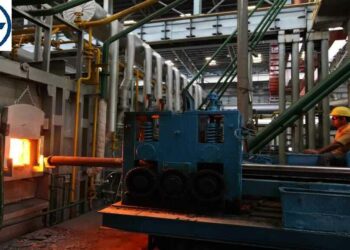Copper Faces Tariff Threat Amid Rising U.S.-LME Premium
The U.S. copper market is bracing for potential tariff impositions, with the premium between CME and London Metal Exchange (LME) copper contracts widening in response to speculation that the red metal might follow aluminium and steel in facing import duties.
U.S. President Donald Trump hasn’t yet imposed import tariffs on copper but the market is already pricing in the likelihood that the red metal will be next on the list after aluminium and steel.
The CME premium exceeded $1,000 per metric ton earlier this week, signaling market expectations of a 10% tariff at minimum. However, if 25% blanket tariffs, similar to those targeting steel and aluminium, are applied, the CME premium could rise even further.
The arbitrage gap reflects more than just tariff speculation. It highlights the vulnerability of the U.S. copper market, which depends on imports for 45% of domestic consumption, according to the U.S. Geological Survey (USGS). The gap also underscores the complexity of global trade flows and how they could be disrupted by trade policies.
Mind the Widening Gap
The widening premium mirrors the tariff-driven dynamics already seen in the aluminium market. The CME aluminium contract, which reflects U.S. Midwest premium costs, has adjusted to include additional tariff-related pricing.
For copper, the CME contract inherently factors in U.S. delivery costs, making it a tradable gauge for potential tariffs on copper imports. With the U.S. copper premium now trading at record highs, it surpasses even the levels caused by last year’s short squeeze.
Although CME copper stocks have risen to over 100,000 tons, the U.S. remains heavily dependent on imports, with 800,000 tons of refined copper imported in 2024, compared to domestic production of 850,000 tons, according to the USGS.
The blanket nature of this week’s announced tariffs on aluminium and the potential for even higher duties in the event of retaliation by trading partners has evidently spooked the copper market, forcing the arbitrage ever wider.
Damage Impact
The immediate concern for the U.S. copper market is the tariff impact on refined metal imports, but the ripple effects could extend beyond. The U.S., Mexico, and Canada maintain an intricate copper trade relationship, and the proposed 25% tariffs threaten to disrupt these established flows.
For instance, the U.S. exports 220,000 tons of copper wire to Mexico annually, where it is manufactured into automotive components such as wiring harnesses and electric motors. These parts are then re-imported into the U.S. for use in vehicle production.
Slapping high tariffs on such imports is likely to see harness assembly relocate from Mexico to lower-cost Asian countries with negative knock-on effects for both Mexican and U.S. companies in the automotive supply chain.
Moreover, both Canada and Mexico supply U.S. processors with significant amounts of copper scrap. Tariffs could divert this scrap to other countries, especially China, which would reduce the availability of secondary copper in the domestic U.S. market. This could negatively impact U.S.-based secondary production facilities.
Tariff Drag and Global Growth Concerns
Copper’s role as a global economic barometer means it is highly sensitive to geopolitical and trade tensions. Known as Doctor Copper, the metal is deeply embedded in the global industrial economy.
The interconnectedness of North American copper flows is just part of a bigger complex globalised picture, leaving the metal highly vulnerable to the sort of shift in trading patterns likely to ensue from U.S. tariffs.
In addition to U.S.-Mexico-Canada trade flows, the potential for tit-for-tat tariffs with other trading partners could harm global consumption levels. This escalates concerns about the long-term impact on global growth.
While the LME copper price has risen by 7% since January on expectations of stronger Chinese demand, escalating tariff tensions could put downward pressure on international prices even as the CME premium widens further.
Doctor Copper has earned the honorific title precisely because the metal is so embedded in the global industrial economy.
Conclusion
As the copper market adjusts to the threat of U.S. tariffs, the widening CME-LME premium reflects growing uncertainty. While short-term trade flows may shift to mitigate tariff impacts, the long-term effects on global supply chains and consumption could be far-reaching.
The U.S. copper market remains highly vulnerable to tariff-driven disruptions, and the interconnected nature of global copper flows could amplify the economic consequences. For now, the arbitrage gap serves as a gauge for both potential tariffs and the broader implications of a trade war involving copper.










